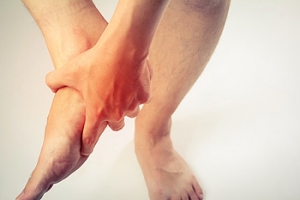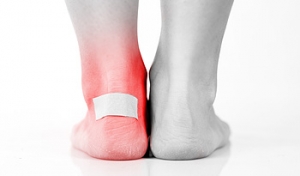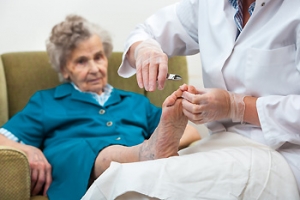Call us directly: (623) 328-8577
18731 N. Reems Road, Suite 640
Surprise, AZ 85374
View Location
Follow us on Facebook ![]()

Possible Methods to Find Relief from Foot Pain
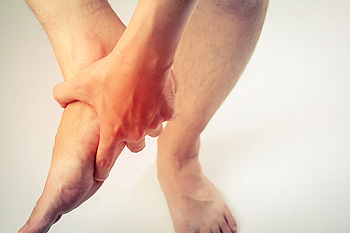 Patients who have chronic foot pain are familiar with the discomfort it can cause. Completing daily activities may be challenging as a result of the dull aches or shooting pains that are present in the feet. There are several reasons why pain in the feet may occur. These include fractures, plantar fasciitis, or Achilles tendonitis. There are methods that can be implemented which may provide mild relief. Many people have found it beneficial to lose weight, as this may help to reduce stress on the joints in the feet and toes. Additionally, it is worthwhile to perform proper stretching techniques which can help to diminish the risk of injury. Receiving regular massages may aid in managing chronic foot suffering, and wearing shoes that are comfortable can ease the pain. If you have pain in your feet, it is suggested to consult with a podiatrist who can properly treat any type of foot affliction.
Patients who have chronic foot pain are familiar with the discomfort it can cause. Completing daily activities may be challenging as a result of the dull aches or shooting pains that are present in the feet. There are several reasons why pain in the feet may occur. These include fractures, plantar fasciitis, or Achilles tendonitis. There are methods that can be implemented which may provide mild relief. Many people have found it beneficial to lose weight, as this may help to reduce stress on the joints in the feet and toes. Additionally, it is worthwhile to perform proper stretching techniques which can help to diminish the risk of injury. Receiving regular massages may aid in managing chronic foot suffering, and wearing shoes that are comfortable can ease the pain. If you have pain in your feet, it is suggested to consult with a podiatrist who can properly treat any type of foot affliction.
Foot Pain
Foot pain can be extremely painful and debilitating. If you have a foot pain, consult with Dr. David K. Lee from Arches Foot Institute. Our doctor will assess your condition and provide you with quality foot and ankle treatment.
Causes
Foot pain is a very broad condition that could be caused by one or more ailments. The most common include:
- Bunions
- Hammertoes
- Plantar Fasciitis
- Bone Spurs
- Corns
- Tarsal Tunnel Syndrome
- Ingrown Toenails
- Arthritis (such as Gout, Rheumatoid, and Osteoarthritis)
- Flat Feet
- Injury (from stress fractures, broken toe, foot, ankle, Achilles tendon ruptures, and sprains)
- And more
Diagnosis
To figure out the cause of foot pain, podiatrists utilize several different methods. This can range from simple visual inspections and sensation tests to X-rays and MRI scans. Prior medical history, family medical history, and any recent physical traumatic events will all be taken into consideration for a proper diagnosis.
Treatment
Treatment depends upon the cause of the foot pain. Whether it is resting, staying off the foot, or having surgery; podiatrists have a number of treatment options available for foot pain.
If you have any questions, please feel free to contact our office located in Surprise, AZ. We offer the newest diagnostic and treatment technologies for all your foot care needs.
Read more about Foot PainFoot Pain
The feet, being the foundation of the body, carry all of the body’s weight and are therefore prone to experiencing pain and discomfort. If you are experiencing foot pain, it is important to determine where in the foot you are experiencing this pain to help discover the cause of it. While pain can be experienced virtually anywhere in the foot, the most common sites of foot pain are in the heel and ankle.
Heel pain can be due to a multitude of conditions including plantar fasciitis, Achilles tendinitis, and heel spurs. Pain experienced in the ankle can be a sign of an ankle sprain, arthritis, gout, ankle instability, ankle fracture, or nerve compression. In more serious cases, pain in the foot can be a sign of improper alignment or an infection.
Foot pain can be accompanied by symptoms including redness, swelling, stiffness and warmth in the affected area. Whether the pain can be described as sharp or dull depends on the foot condition behind it. It is important to visit your local podiatrist if your foot pain and its accompanying symptoms persist and do not improve over time.
Depending on the location and condition of your foot pain, your podiatrist may prescribe certain treatments. These treatments can include but are not limited to prescription or over-the-counter drugs and medications, certain therapies, cortisone injections, or surgery.
If you are experiencing persistent foot pain, it is important to consult with your foot and ankle doctor to determine the cause and location. He or she will then prescribe the best treatment for you. While milder cases of foot pain may respond well to rest and at-home treatments, more serious cases may take some time to fully recover.
Preparing For Foot Surgery
 If you are scheduled for any type of foot surgery, it is wise to prepare for an appropriate recovery period. Many patients find it beneficial to ask friends and family for a helping hand, in addition to having adequate amounts of food available prior to the surgery. It will help to have essential items as near to you as possible, as this may help in preventing unnecessary walking on the affected foot. Immediately following surgery, you will most likely experience swelling, and this may last for several days. The majority of the swelling will gradually diminish as the healing process occurs. If you would like additional information about how to prepare for an upcoming foot surgery, please consult with a podiatrist.
If you are scheduled for any type of foot surgery, it is wise to prepare for an appropriate recovery period. Many patients find it beneficial to ask friends and family for a helping hand, in addition to having adequate amounts of food available prior to the surgery. It will help to have essential items as near to you as possible, as this may help in preventing unnecessary walking on the affected foot. Immediately following surgery, you will most likely experience swelling, and this may last for several days. The majority of the swelling will gradually diminish as the healing process occurs. If you would like additional information about how to prepare for an upcoming foot surgery, please consult with a podiatrist.
Foot surgery is sometimes necessary to treat a foot ailment. To learn more, contact Dr. David K. Lee of Arches Foot Institute. Our doctor will assist you with all of your foot and ankle needs.
When Is Surgery Necessary?
Foot and ankle surgery is generally reserved for cases in which less invasive, conservative procedures have failed to alleviate the problem. Some of the cases in which surgery may be necessary include:
- Removing foot deformities like bunions and bone spurs
- Severe arthritis that has caused bone issues
- Cosmetic reconstruction
What Types of Surgery Are There?
The type of surgery you receive will depend on the nature of the problem you have. Some of the possible surgeries include:
- Bunionectomy for painful bunions
- Surgical fusion for realignment of bones
- Neuropathy decompression surgery to treat nerve damage
Benefits of Surgery
Although surgery is usually a last resort, it can provide more complete pain relief compared to non-surgical methods and may allow you to finally resume full activity.
Surgical techniques have also become increasingly sophisticated. Techniques like endoscopic surgery allow for smaller incisions and faster recovery times.
If you have any questions please feel free to contact our office located in Surprise, AZ. We offer the newest diagnostic and treatment technologies for all your foot and ankle needs.
Read more about Foot SurgeryFoot Surgery
In most cases, foot surgery is often chosen as the last available option for conditions that have otherwise been unsuccessfully treated. Surgery may be necessary for several reasons, including the removal of foot deformities (e.g. bone spurs or bunions), arthritis problems, reconstruction due to injury, and congenital malformations (e.g. club foot or flat feet). Regardless of one’s age, foot surgery may be the only successful option for treatment for certain conditions.
The type of surgery one undergoes depends on the type of foot condition the patient has. For the removal of a bunion growth, a bunionectomy is necessary. If the bones in the feet need to be realigned or fused together, a surgical fusion of the foot is needed. For pain or nerve issues, a patient may require surgery in which the tissues surrounding the painful nerve are removed. Initially, less invasive treatments are generally attempted; surgery is often the last measure taken if other treatments are unsuccessful.
While in many cases surgery is often deemed as the final resort, choosing surgery comes with certain benefits. The associated pain experienced in relation to the particular condition is often relieved with surgery, allowing patients to quickly resume daily activities. The greatest benefit, however, is that surgery generally eliminates the problem immediately.
Podiatry history has shown that foot treatments continue to evolve over time. In the field of foot surgery, endoscopic surgery is just one of the many advanced forms of surgery. As technology vastly improves so too will the various techniques in foot surgery, which already require smaller and smaller incisions with the use of better and more efficient tools. Thanks to such innovations, surgery is no longer as invasive as it was in the past, allowing for faster and easier recoveries.
What Causes Blisters on the Feet?
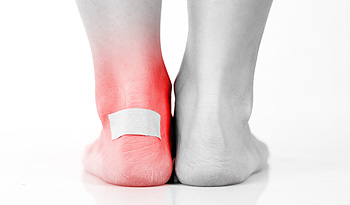 A blister that forms on the foot may develop for a variety of reasons. These may include friction that comes from frequent running, a burn that occurs on the foot, or an allergic reaction to an insect bite. Additionally, blisters may form from wearing shoes that fit poorly. When a blister occurs, the small portion of the affected area of the skin becomes irritated, and the top layer of skin becomes raw. The body’s natural defense is to protect the area by forming a bubble filled with fluid over it. As the skin begins to heal, the fluid will gradually drain, and the blister will disappear. If the blister is in an uncomfortable area, mild relief may be found if it is drained. This can be accomplished by cleaning the blister with alcohol and carefully puncturing the area, which will allow complete drainage. It is important to apply an antibacterial cream to the area, followed by covering the blister with a bandage. If you have blisters on your feet that are causing pain and discomfort, it is suggested that you consult with a podiatrist who can treat this condition.
A blister that forms on the foot may develop for a variety of reasons. These may include friction that comes from frequent running, a burn that occurs on the foot, or an allergic reaction to an insect bite. Additionally, blisters may form from wearing shoes that fit poorly. When a blister occurs, the small portion of the affected area of the skin becomes irritated, and the top layer of skin becomes raw. The body’s natural defense is to protect the area by forming a bubble filled with fluid over it. As the skin begins to heal, the fluid will gradually drain, and the blister will disappear. If the blister is in an uncomfortable area, mild relief may be found if it is drained. This can be accomplished by cleaning the blister with alcohol and carefully puncturing the area, which will allow complete drainage. It is important to apply an antibacterial cream to the area, followed by covering the blister with a bandage. If you have blisters on your feet that are causing pain and discomfort, it is suggested that you consult with a podiatrist who can treat this condition.
Blisters may appear as a single bubble or in a cluster. They can cause a lot of pain and may be filled with pus, blood, or watery serum. If your feet are hurting, contact Dr. David K. Lee of Arches Foot Institute. Our doctor can provide the care you need to keep you pain-free and on your feet.
Foot Blisters
Foot blisters are often the result of friction. This happens due to the constant rubbing from shoes, which can lead to pain.
What Are Foot Blisters?
A foot blister is a small fluid-filled pocket that forms on the upper-most layer of the skin. Blisters are filled with clear fluid and can lead to blood drainage or pus if the area becomes infected.
Symptoms
(Blister symptoms may vary depending on what is causing them)
- Bubble of skin filled with fluid
- Redness
- Moderate to severe pain
- Itching
Prevention & Treatment
In order to prevent blisters, you should be sure to wear comfortable shoes with socks that cushion your feet and absorb sweat. Breaking a blister open may increase your chances of developing an infection. However, if your blister breaks, you should wash the area with soap and water immediately and then apply a bandage to the affected area. If your blisters cause severe pain it is important that you call your podiatrist right away.
If you have any questions, please feel free to contact our office located in Surprise, AZ. We offer the newest diagnostic and treatment technologies for all your foot care needs.
Read more about BlistersBlisters
Blisters are pockets of fluid that occur under the top layer of your skin. These fluid pockets are usually filled with pus, blood, or serum. Blisters may itch or hurt and can appear as a single bubble or in clusters.
The most common types of blisters are friction blisters. This type of blister may be caused by wearing shoes that are too tight. Friction blisters can also occur on the hands. A change in temperature may also cause blisters on the feet. In the freezing air, frostbite on your toes can lead to blisters, as well as sunburn from hot weather.
The best way to treat a blister is to keep it clean and dry. Most blisters will get better on their own. Once the skin absorbs the fluid within the blister, it will flatten and eventually peel off. You should avoid popping your blister unless you podiatrist does it for you. Additional treatment options include applying an ice pack to the blister or using over-the-counter blister bandages to cover the affected area.
If your blister becomes discolored, inflamed, or worsens it is advised that you speak to your podiatrist. Blisters that are yellow, green, or purple may be infected and require immediate medical attention. Blisters that are abnormally colored may be a sign of a more serious underlying health condition such as herpes.
Are You Suffering from Ingrown Toenails?
Existing Medical Conditions May Lead to Foot Pain
Foot pain is common among elderly people. This may be a result of existing medical conditions, including arthritis, poor circulation, and diabetes. It is helpful to examine the bottom of the feet for any cuts, cracks in the skin, or blisters that are present. When the toenails are trimmed properly, ingrown toenails may be prevented. Research has indicated the feet will generally feel better when gentle stretching techniques are frequently practiced. This is beneficial in loosening any muscles that are tense. Additionally, it is helpful to wear socks that do not have a seam, which may aid in promoting proper blood flow. If you would like more information about how to care for elderly feet, it is suggested that you consult with a podiatrist.
Proper foot care is something many older adults forget to consider. If you have any concerns about your feet and ankles, contact Dr. David K. Lee from Arches Foot Institute. Our doctor can provide the care you need to keep you pain-free and on your feet.
The Elderly and Their Feet
As we age we start to notice many changes in our body, but the elder population may not notice them right away. Medical conditions may prevent the elderly to take notice of their foot health right away. Poor vision is a lead contributor to not taking action for the elderly.
Common Conditions
- Neuropathy – can reduce feeling in the feet and can hide many life-threatening medical conditions.
- Reduced flexibility – prevents the ability of proper toenail trimming, and foot cleaning. If left untreated, it may lead to further medical issues.
- Foot sores – amongst the older population can be serious before they are discovered. Some of the problematic conditions they may face are:
- Gouging toenails affecting nearby toe
- Shoes that don’t fit properly
- Pressure sores
- Loss of circulation in legs & feet
- Edema & swelling of feet and ankles
Susceptible Infections
Diabetes and poor circulation can cause general loss of sensitivity over the years, turning a simple cut into a serious issue.
If you have any questions please feel free to contact our office located in Surprise, AZ. We offer the newest diagnostic and treatment technologies for all your foot and ankle needs.
Read more about Taking Care of Elderly FeetTaking Care of Elderly Feet
Many foot diseases and conditions become more serious and common among the elderly. Some of these conditions include diabetic ulcers, ingrown toenails, fungus, arthritis, corns, and calluses. Unfortunately, it may be harder for older adults to take care of their own feet, but there are some precautions they can take in order to avoid any serious conditions.
Dry, cracked heels tend to be a common problem for older people. In order to avoid this, you should always keep your feet clean and well moisturized. Special feet moisturizers should be used as average lotions might not provide enough moisture for dry and cracked heels. Daily foot inspections are crucial for the elderly to detect any irregularities in their earliest stages. During the aging process, blood circulation tends to slow down causing older people to not feel their feet as well as they used to. This often results in foot problems going unnoticed.
Fungal and bacterial conditions thrive on elderly feet because older adults are less likely to keep their feet clean and dry; this makes it easier for bacteria to take hold in their dry, cracked skin. Elderly people should be sure to thoroughly dry their feet, especially in between the toes, after bathing. This will help them avoid developing any fungal infections. Additionally, clean cotton socks should be worn after the feet are dried.
Cutting toenails straight across will help prevent ingrown toenails. When toenails are cut too lose, the nail might break through the skin resulting in an ingrown nail. Clippers should be used to cut the nails in order to make the cut even.
Elderly people who have diabetes are at risk of developing serious foot problems that may lead to amputation. Ulcers that are left untreated can lead to gangrene. Dry and cracked feet, fungus, and untended cuts under the nails may also lead to infections.
Fortunately, Medicare covers many different types of services for foot care. Elderly people with any of these foot conditions should seek the help of a podiatrist and perform daily foot inspections in order to ensure that they have healthy feet.
Ballet Dancers and Ingrown Toenails
 Research has indicated many ballet dancers are afflicted with ingrown toenails. This is often the result of balancing on top of the toes, which can cause the corner of the nail to grow into the surrounding skin. An ingrown toenail typically causes pain and discomfort and may become infected if it is not treated promptly. Many ballet dancers may notice soreness while putting on ballet slippers and pointing the toes can cause extreme pain. Some of the symptoms associated with ingrown toenails can include swelling around the nail, or you may notice a discharge draining from the nail. Mild relief can be found when the toe is soaked in warm water and is helpful in softening the skin around the affected area. If you feel you have an ingrown toenail, consult with a podiatrist so proper treatment can begin.
Research has indicated many ballet dancers are afflicted with ingrown toenails. This is often the result of balancing on top of the toes, which can cause the corner of the nail to grow into the surrounding skin. An ingrown toenail typically causes pain and discomfort and may become infected if it is not treated promptly. Many ballet dancers may notice soreness while putting on ballet slippers and pointing the toes can cause extreme pain. Some of the symptoms associated with ingrown toenails can include swelling around the nail, or you may notice a discharge draining from the nail. Mild relief can be found when the toe is soaked in warm water and is helpful in softening the skin around the affected area. If you feel you have an ingrown toenail, consult with a podiatrist so proper treatment can begin.
Ingrown toenails may initially present themselves as a minor discomfort, but they may progress into an infection in the skin without proper treatment. For more information about ingrown toenails, contact Dr. David K. Lee of Arches Foot Institute. Our doctor can provide the care you need to keep you pain-free and on your feet.
Ingrown Toenails
Ingrown toenails are caused when the corner or side of a toenail grows into the soft flesh surrounding it. They often result in redness, swelling, pain, and in some cases, infection. This condition typically affects the big toe and may recur if it is not treated properly.
Causes
- Improper toenail trimming
- Genetics
- Improper shoe fitting
- Injury from pedicures or nail picking
- Abnormal gait
- Poor hygiene
You are more likely to develop an ingrown toenail if you are obese, have diabetes, arthritis, or have any fungal infection in your nails. Additionally, people who have foot or toe deformities are at a higher risk of developing an ingrown toenail.
Symptoms
Some symptoms of ingrown toenails are redness, swelling, and pain. In rare cases, there may be a yellowish drainage coming from the nail.
Treatment
Ignoring an ingrown toenail can have serious complications. Infections of the nail border can progress to a deeper soft-tissue infection, which can then turn into a bone infection. You should always speak with your podiatrist if you suspect you have an ingrown toenail, especially if you have diabetes or poor circulation.
If you have any questions, please feel free to contact our office located in Surprise, AZ. We offer the newest diagnostic and treatment technologies for all your foot care needs.
Read more about Ingrown Toenail Care
(623) 328-8577
Arches Foot Institute
18731 N. Reems Road, Suite 640
Surprise, AZ 85374
© Arches Foot Institute | Cosmetic Foot Surgery | David Lee, DPM
Surprise Podiatrist | Surprise Podiatry | Surprise Foot Doctor


